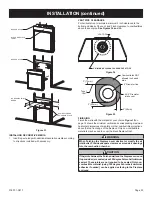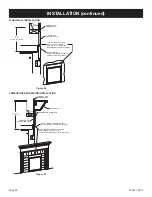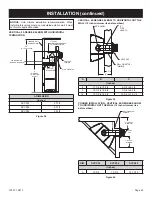
37607-1-0817
Page 17
GAS SUPPLY
The gas pipeline can be brought in through the right or left side of
the appliance. Consult the current National Fuel Gas Code, ANSI
Z223.1 CAN/CGA-B149 (.1 or .2) installation code.
2”
4 5/8”
RIGHT SIDE OF FIREBOX
Figure 23
Figure 24
Recommended Gas Pipe Diameter
Pipe Length
Schedule 40 Pipe
Inside Diameter
Tubing, Type L
Outside Diameter
(Inches)
(Inches)
Nat
LP
Nat
LP
0-10 feet
1/2
3/8
1/2
3/8
10-40 feet
1/2
1/2
5/8
1/2
40-100 feet
1/2
1/2
3/4
1/2
100-150 feet
3/4
1/2
7/8
3/4
NOTICE:
Never use plastic pipe. Check to confirm whether your
local codes allow copper tubing or galvanized.
NOTICE:
Because some municipalities have additional local codes,
consult your local authority and installation code.
The use of the following gas connectors is recommended:
— ANSI Z21.24 Appliance Connectors of Corrugated Metal Tubing
and Fittings.
— ANSI Z21.45 Assembled Flexible Appliance Connectors of
Other Than All-Metal Construction
The above connectors may be used if acceptable by the authority
having jurisdiction. The Commonwealth of Massachusetts requires
that a flexible appliance connector cannot exceed three feet in length.
A gas valve and ground joint union should be installed in the gas
line upstream of the gas control to aid in servicing. It is required
by the National Fuel Gas Code that a drip leg be installed near the
gas inlet.
See Figure 25.
This should consist of a vertical length of
pipe tee connected into the gas line that is capped on the bottom
in which condensation and foreign particles may collect.
Installing a New Main Gas Supply Valve (Check Local Code)
Each appliance should have its own manual gas supply valve.
A manual main gas supply valve should be located in the vicinity of the
unit. Where none exists, or where its size or location is not adequate,
contact your local authorized installer for installation or relocation.
Compounds used on threaded joints of gas piping shall be resistant
to the action of liquefied petroleum gases.
The gas lines must be checked for leaks by the installer. This should
be done with a soap solution watching for bubbles on all exposed
connections, and if unexposed, a pressure test should be made.
WARNING
Never use an exposed flame to check for leaks. Appliance
must be disconnected from piping at inlet of control valve and
pipe capped or plugged for pressure test. Never pressure test
with appliance connected; control valve will sustain damage!
Figure 25
NOTICE:
The millivolt gas controls are equipped with a captured
screw type pressure test point, therefore it is not necessary to provide
a 1/8 inch test point up stream of the control.
On direct ignition valves, hex plugs may be replaced with hose fittings
for pressure checks, then reinstalled before operating fireplace.
When using copper or flex connector use only approved fittings.
The fireplace and its individual shut off valve must be disconnected
from supply piping system during any pressure testing of that system
at test pressures in excess of 1/2 psig (3.5kPa).
The fireplace must be isolated from the gas supply piping system
by closing its individual manual shut off valve during any pressure
testing of the gas supply piping system at test pressures equal to
or less than 1/2 psig (3.5kPa).
WARNING
Pressures in excess of 1/2 psig (14 inches w.c.) (3.5kPa) on
the fireplace gas valve, may damage the valve.
Checking Manifold Pressures
Both Propane and Natural gas valves have a built-in pressure regulator.
Natural gas models will have a manifold pressure of approximately 3.5
inches w.c. (.871kPa) at the valve outlet with the inlet pressure to the
valve from a minimum of 4.5 inches w.c. (1.120kPa) for the purpose
of input adjustment to a maximum of 14.0 inches w.c. (3.484kPa).
Propane gas models will have a manifold pressure approximately 10.0
inches w.c. (2.49kPa) at the valve outlet with the inlet pressure to the
valve from a minimum of 10.8 inches w.c. (2.68kPa) for the purpose
of input adjustment to a maximum of 14.0 inches w.c. (3.484 kPa).
Gas Supply Pressure (inches w.c.)
Minimum
Normal
Maximum
Natural Gas
4.5
7.0
14.0
LP (Propane)
10.8
11.0
14.0
Manifold Pressure (inches w.c.)
Natural Gas
3.5 - Normal (HI)
LP (Propane)
10.0 - Normal (HI)






























